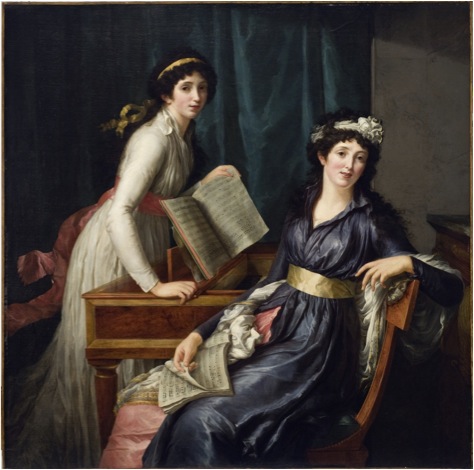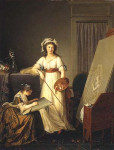
Marie Victoire Lemoine
French, 1754-1820
Portrait of Mme. D'Erceville and Her Daughter
oil on canvas
SBMA, Gift of Mrs. Hugh N. Kirkland, 1952

Atelier of a Painter - Description: The painting has been identified with one exhibited by Marie Victoire Lemoine in the Salon of 1796. It is a tribute by one woman artist to another. Vigée Le Brun, had been closely associated with Marie Antoinette before the Revolution and at its outbreak in 1789 left France (in 1796 she was living in St. Petersburg). She is shown palette and mahlstick in hand, pausing from work on an Antique-inspired subject, a votary of Athena goddess of wisdom and patron of the arts, while a pupil (sometimes identified with Lemoine herself) copies from it. The picture has been interpreted as a eulogy of Vigée Le Brun as a sort of high priestess of painting and a protagonist of female artists. Atelier of a Painter, Gift of Mrs. Thorneycroft. Ryle, 1957 (57.103), Metropolitan Museum of Art.
RESEARCH PAPER
History of Attribution
Although this painting is tentatively attributed to Marie Victoire Lemoine, it has a history of misattribution, and remains somewhat of a mystery to this day. It is fascinating and informative to follow the process with which the attribution was examined. The painting came to us in 1952 with this title; we do not know how it was originally identified. Thought to have been painted by Adelaide Labille-Guiard , it was exhibited as such in a 1977 SBMA exhibition, "The Many Faces of Women".
In 1987, Barry Heisler, Curator of Collections at SBMA, suggested that the piece is much closer to Elisabeth Vigee LeBrun. He believes this notion is supported by the coloration of the room with its deep hues, "far from the muted tones of Labille-Guiard." In that same year, Joseph Baillio, an noted expert on Vigee LeBrun, counters with the observation that the piece has nothing to do, stylistically, with Vigee LeBrun or Labille-Guiard. He calls it "a very curious painting indeed", and refers to it as "mannerist", probably because of the elongation of the figures. His belief is that it was perhaps painted by a non-Parisian artist, since he doesn’t recognize the style.
In 1993, Mr. Edward Streator of the National Gallery of London suggested that Lemoine painted this portrait, and this attribution was adopted by our museum. However, some mysteries remain, and may one day be solved with new information. Why didn’t the painter sign the work? Why are all the attributed painters women? When was the actual date of the work?
The Artist
Marie Victoire Lemoine was part of a generation of women who were able to enjoy considerable success as professional artists. Before this time, women weren’t really able to become artists, with a few rare exceptions who were all sisters or daughters of artists. This was the first period in history where a female artist was not an obscure oddity, and she was one of the first women artists to come into prominence in Paris once the official Salon was opened to women in 1791. Born in Paris, she followed on the heels of a long tradition of French portraiture, and also produced miniatures as well as oils and genre paintings.
Lemoine studied with Menageot and is thought to have been a student of Vigee LeBrun herself. She exhibited in the Salons 1779-1785, as well as those of 1796-1814. Her career spanned the periods both before and after the French Revolution.
Though allowed formal artistic training, women artists were restricted in their artistic expression. According to the rules of the French Academy, women were banned from studying the live nude model. Thus, women artists painted primarily portraiture, rather than the more esteemed subjects of history and mythology. This limitation proved to be a virtue for Lemoine, as she concentrated on the expert rendering of faces and fabrics.
It is interesting to note that both of the painters to whom Mme. D’Erceville was originally attributed were rivals! Both Labille-Guiard and Vigee LeBrun were admitted to the Academie Royale on the same day in 1783, at a time when only four seats were designated for female painters. Labille-Guiard, whose brush style was bold and vigorous, was said to "paint like a man". Indeed, the accusation was made that a woman alone could not have done such fine work. When this slander threatened her admittance into the Academie, she did portraits of each of the academicans so they could see that she worked alone.
We know of two other paintings of Lemoine’s in the United States. One, Zamor, is at the Cummer Museum of Art in Jacksonville, Florida. The other more known work is Atelier of a Painter, seen at the Metropolitan Museum of Art. This picture has been identified with one exhibited by Lemoine in the Salon of 1796, and is a tribute to and portrait of Vigee LeBrun. It shows Lebrun with a pupil, sometimes thought to be Lemoine. This painting eulogizes LeBrun as a sort of high priestess of painting and a protagonist of female artists. LeBrun, a celebrated artist in her time, is often remembered for her fame as the portraitist of Marie Antoinette.
The Painting
Our painting is of a mother and daughter, who were part of the fashionable world of late 18th Century Paris. Joseph Baillio, in a 1987 letter to SBMA, directed our attention to a similar painting by Rose Ducreux in an attempt to aid us in our search for an accurate attribution. He had discovered in his research that M. D’Erceville had been President of the Paris Parlement, and was guillotined during the Revolution. However, we see no evidence of this trauma in the faces of our subjects.
This painting was done during the Neoclassical Period, which is reflected in Lemoine’s technique of clear precise forms with no trace of brushstrokes, idealized beauty, and balanced composition.
Words that come to mind when viewing this painting: charming, stylish, detailed, inviting, intimate, informal. We feel welcomed into this space as viewers. The women are not formally posed, and we feel we are joining a moment in time as we approach this painting. The daughter leans forward toward the mother, as she reclines casually backward in her chair.
We notice the use of deep hues and jewel-like colors, as well as the beautiful rendering of fabric for which Lemoine is noted. A touch of gold in the daughter’s hair and echoed in the mother’s belt establishes their relationship. The stole around the mother looks real, and you can feel the gauzy texture of her wrap. We also see attention to texture and detail in the matte of the gold ribbon, the burling and smooth patina of the wood, and the parchment of the pages of music. We notice the mother’s hand curled around the music, and the rough edges of the music, in addition to the crinkled paper behind the music on the stand. (The lyrics in the songbook were carefully examined to search for clues as to the song in hopes to link it to a painter or period, but there is no recognizable melody and the lyrics are illegible.)
The women are dressed simply, without jewelry. In addition to their clothing, both the chair and the chest appear to be from the Empire Period of Napoleon. Their hair is very natural and not highly styled; they don’t seem to be trying to impress the viewer. We see a repetition of shapes in the folds of the gowns and the curtains, and in the soft and curly hair of the women. Our eyes flow back and forth between the faces of the women. We notice that the ribbon on the daughter’s dress is fluttering in a breeze, although their hair and no other garments appear to be fluttering! (Perhaps the artist was working on portraying the movement in a garment.) A ray of light from the left illuminates the painting and creates a play of shadows in the background. The paint is blended, with a smooth brush stroke, creating a " licked" surface.
This portrait is unusual in that it is of two women relating to each other, rather than of an individual, and this makes it difficult to compare to other portraits in our gallery.
Bibliography: Madame D’Erceville and her daughter
Baillio, Joseph, Elisabeth Louise Vigee Le Brun, Copyright by the Kimbell Art Museum and Joseph Ballio, 1982.
Benzoit, E., Dictionnaire des Peintres, Scripteurs, Dessinteurs, et Graveurs, Vol. 19, Printed in France, 1976.
Pettys, Chris, Dictionary of Women Artists, G.K.Hull and Co., 1985.
Rosenberg, Pierre, French Painting, 1774-1830, The Age of Revolution, Detroit Institute of Arts and the Metropolitan Museum of Art, 1975.
Rosenblum and Jansen, Nineteenth Century Art, Harry N. Abrams, Inc, Publishers, NY, 1984.
Sheriff, Mary, The Exceptional Woman, Elisabeth Vigee Le Brun and the Cultural, Politics of Art , University of Chicago Press, October, 1996.
Walters Art Gallery, Old Mistresses: Women Artists of the Past, April17-June18,1972.
